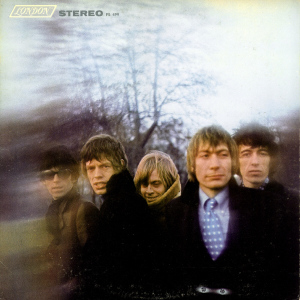The Rolling Stones – Between the Buttons London PS 499 (1967) [US release]
Starry-eyed idealism worked wonders for The Beatles. The Kinks had nostalgia. For The Rolling Stones, the raw energy of rock and roll was their near constant source of inspiration. Early on, The Stones worked exclusively with the blues and R&B at the root of all rock music. That soon changed. It was a pair of albums they put out in 1967 that confounded any notion of the group being easily placed in one category of rock and pop music. Between The Buttons was the first of those. The album, and especially the U.S. version with the singles “Let’s Spend the Night Together” and “Ruby Tuesday,” has all the catchy pop hooks of a Beatles record plus all the ragged stylistic shredding of any other Stones record.
“Let’s Spend the Night Together” is joy. The simple pleading of a boy in love, Jagger encouraged to a desperate pace confirmed in the wordless ba-duh-bap-bap of his associates and the prodding of a relentless piano. Desire is so strong that doubt hasn’t room to breathe. This could be the most uninhibited song the group recorded. For purity of emotion, there is no equal. Pleading, pleading, pleading, with the moment ready to pass sweetly by, every attempt is made to realize the possibilities that could, at any time, collapse under the effort convince some exquisite being of something that words hardly convey, with another plea, and another, the beautiful possibility–excuses, apologies fail–for a wonderful night together. Trembling with confidence, there can only be success. The bass rambles by, undeterred by anything around it. The guitars drift in and out. They mirror the strongest melodies, making them practically invincible.
“Ruby Tuesday,” an exposition of simply the finest baroque chamber pop, matches its aristocratic etiquette only in its bittersweet delicacy. Its coarser sibling is “Yesterdays Paper’s,” whose treatment of a casual dismissal overflows with neglect.
In every odd turn the album takes, a surprise is waiting. “Connection” is a driving piece, full of energy. Less obvious are the textures loaded in every pulse. “She Smiled Sweetly” sways on the tones of an organ, with a romantic attachment to lingering memories and the instinctive desire to live them again. What makes the song unshakable is the plain and honest fact that the sweet smiles of those very occasional girls who put the world within reach can keep you alive for months. If she tells you not to worry, then days become a blur. The blur is the image of her blending bleeding into everything else. Having her in mind is happiness. All that comes in a song.
The Rolling Stones’ greatest ability was in absorbing the possibilities of every kind of pop music. In that way, Between the Buttons is exactly in stride with the path of a group who had already mastered their own heartfelt transformation of American blues. The focus simply moved to encompass the sweeter strains of pop. Even still, their music is open to anything. “Miss Amanda Jones” is a manic workout that looks forward to sound The Stones took up a few years later. The vaudevillian humor in “Something Happened to Me Yesterday” and elsewhere takes the eccentricities of the album the furthest. So carefree. Between the Buttons is wonderful nonsense, and one of the group’s best efforts.

